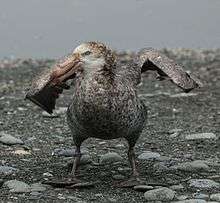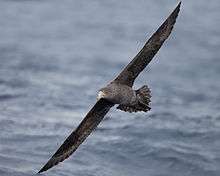Northern giant petrel
| Northern giant petrel | |
|---|---|
 | |
| Flying over Godthul, South Georgia, British Overseas Territories | |
| Scientific classification | |
| Kingdom: | Animalia |
| Phylum: | Chordata |
| Class: | Aves |
| Order: | Procellariiformes |
| Family: | Procellariidae |
| Genus: | Macronectes |
| Species: | M. halli |
| Binomial name | |
| Macronectes halli Mathews, 1912[2] | |
 | |
| Global range Year-Round Range Summer Range Winter Range | |
The northern giant petrel (Macronectes halli), also known as the Hall's giant petrel, is a large predatory seabird of the southern oceans. Its distribution overlaps broadly with the similar southern giant petrel, though it overall is centred slightly further north.
Taxonomy
The northern giant petrel along with its counterpart, the southern giant petrel, make up the Macronectes genus. They come from the Procellariiformes order, which are referred to as tube-nosed seabirds, due to their unique nose structure. All tube-noses have tubular nostrils, and all Procellariidae have the openings on top of the upper portion of the bill. Procellariiformes also have between seven and nine distinct horny plates for their bill, and petrels have one of these plates that form the hooked portion of their upper bill called their maxillary unguis. They produce a stomach oil made up of wax esters and triglycerides that is stored in the proventriculus. This can be sprayed out of their mouths as a defence against predators as well as an energy rich food source for chicks and for the adults during their long flights.[3] Finally, they also have a salt gland that is situated above the nasal passage and helps desalinate their bodies, due to the high amount of ocean water that they imbibe. It excretes a concentrated saline solution from their nostrils.[4]
Etymology
Macronectes giganteus can be broken down as makros a Greek word meaning "long" or "large" and nēktēs meaning "swimmer". Northern giant petrel starts with "northern" referring to their habitat being further north than their counterpart the southern giant petrel, and "petrel" refers to Saint Peter and from the story of him walking on water, which refers to how they run on top of the water as they are getting airborne.[5]
Description

.jpg)
The northern giant petrel averages 90 cm (35 in) in length, with a range of 80 to 95 cm (31 to 37 in), possessing a wingspan of 150 to 210 cm (59 to 83 in). Size is somewhat variable and this species is broadly the same size as its southern sister species. The largest-bodied colony is in the South Georgia Islands, where 56 males averaged 4.9 kg (11 lb) and 43 females average 3.72 kg (8.2 lb).[6] The smallest-bodied are on the Chatham Islands, where 19 males averaged 3.66 kg (8.1 lb) and 21 females averaged 2.83 kg (6.2 lb).[7] Overall, weight for the species can range from 2.5 to 5.8 kg (5.5 to 12.8 lb).[6][7] Its plumage consists of grey-brown body with lighter coloured forehead, sides of face, and chin. Its bill is between 90 and 110 mm (3.5–4.3 in) long, being slightly longer on average than the southern giant petrel, and is pinkish yellow with a brown tip, and its eyes are grey. The tarsus of the northern giant petrel is slightly longer on average than the southern species as well, but the southern has longer wings on average.[7] The juvenile of this species is completely dark brown and lightens as it ages. It can be differentiated from the similar coloured southern giant petrel by the top of the bill, which on the southern is green.[8]
Behavior
Feeding
The northern giant petrel feeds mainly on carrion from penguins and pinnipeds, as well as krill, offal, cephalopods, and discarded fish and waste from ships. During the breeding season, males eat more carrion than females with the females feeding on pelagic sources.[8]
Breeding
Birds start breeding at an average age of ten years, and breed on islands in colonies, which they share with the southern giant petrel. They breed six weeks earlier than their counterpart though.[8]
Range and habitat
They are pelagic and fly throughout the Southern Oceans north of the Antarctic Convergence Zone, and north through Chile, Argentina, South Africa, and half of Australia. They nest on islands with the South Georgia group with 4,500 pairs. They also nest on some of the Chatham Islands, Kerguelen Islands, Crozet Islands, Macquarie Island and others. Their overall occurrence range is 82,600,000 km2 (31,900,000 sq mi).[8]
Conservation
| Location | Population | Date | Trend |
|---|---|---|---|
| South Georgia | 4,500 pairs | 2005 | Increasing 30% per 20 yr |
| Forty-Fours | 2,000 pairs | 2000 | |
| Middle Sister | 80–100 pairs | 2000 | |
| Kerguelen Islands | 1,450–1,800 pairs | 1989 | |
| Crozet Islands | 1,300 pairs | 1989 | Decreasing |
| Macquarie Island | 1,300 pairs | Stable or increasing | |
| Prince Edward Islands | 650 pairs | Increasing | |
| Antipodes Island | 230 pairs | 2003 | |
| Campbell Island | 230 pairs | 2000 | |
| Auckland Islands | 50 pairs | 2000 | |
| Total | 17,000–21,000 | 2001 | Increasing 34% per 10 yr |

Overall, their population stands between 17,000 and 21,000 mature birds, based on a 2001 estimate. This number has been increasing over the last two decades, though it was forecasted to decrease. This increase has allowed the IUCN to downgrade them from near threatened to least concern. Recent surveys have shown that most locations are increasing in numbers except for the Crozet Islands. This is probably due to increases in fish waste, better control on longline fishing, and more carrion from fur seals.[8]
Currently, this bird is listed on CMS Appendix II and ACAP Annex 1. Future plans are to maintain the surveys and counting of individuals, researching movement and migrations, continuing the trend of lowering the bycatch deaths by current means and if needed newer measures through CCAMLR, CMS, and FAO.[8]
Footnotes
- ↑ BirdLife International (2012). "Macronectes halli". IUCN Red List of Threatened Species. Version 2013.2. International Union for Conservation of Nature. Retrieved 26 November 2013.
- ↑ BirdLife International (2009a)
- ↑ Double, M. C. (2003)
- ↑ Ehrlich, Paul R. (1988)
- ↑ Gotch, A. T. (1995)
- 1 2 CRC Handbook of Avian Body Masses, 2nd Edition by John B. Dunning Jr. (Editor). CRC Press (2008), ISBN 978-1-4200-6444-5.
- 1 2 3 Carlos, C. J., & Voisin, J. F. (2008). Identifying giant petrels, Macronectes giganteus and M. halli, in the field and in the hand. Publishing Editor, 1.
- 1 2 3 4 5 6 7 BirdLife International (2009)
References
- BirdLife International (2009). "Northern Giant-petrel - BirdLife Species Factsheet". Data Zone. Retrieved 17 Jul 2009.
- BirdLife International (2009a). "The BirdLife checklist of the birds of the world, with conservation status and taxonomic sources." (xls). Retrieved 17 Jul 2009.
- Brooke, M. (2004). "Procellariidae". Albatrosses And Petrels Across The World. Oxford, UK: Oxford University Press. ISBN 0-19-850125-0.
- Double, M. C. (2003). "Procellariiformes (Tubenosed Seabirds)". In Hutchins, Michael; Jackson, Jerome A.; Bock, Walter J.; Olendorf, Donna. Grzimek's Animal Life Encyclopedia. 8 Birds I Tinamous and Ratites to Hoatzins. Joseph E. Trumpey, Chief Scientific Illustrator (2nd ed.). Farmington Hills, MI: Gale Group. pp. 107–111. ISBN 0-7876-5784-0.
- Ehrlich, Paul R.; Dobkin, David, S.; Wheye, Darryl (1988). The Birders Handbook (First ed.). New York, NY: Simon & Schuster. pp. 29–31. ISBN 0-671-65989-8.
- Gotch, A. F. (1995) [1979]. "Albatrosses, Fulmars, Shearwaters, and Petrels". Latin Names Explained A Guide to the Scientific Classifications of Reptiles, Birds & Mammals. New York, NY: Facts on File. p. 190. ISBN 0-8160-3377-3.
External links
| Wikimedia Commons has media related to Macronectes halli. |
- Species factsheet by BirdLife International
- Photos by Christopher Taylor Nature Photography
- Southern and Northern Giant Petrels - Species text in The Atlas of Southern African Birds.
